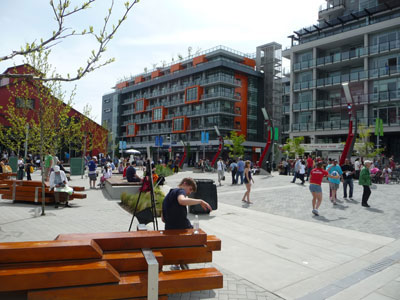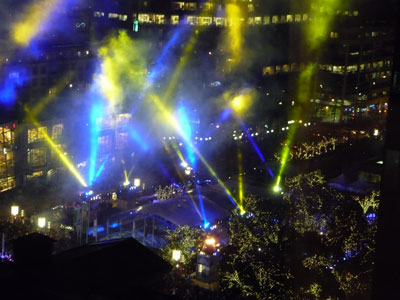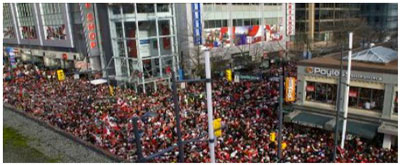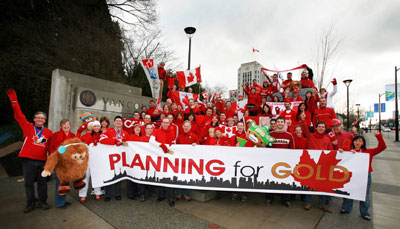As Olympics excitement grows in the first week of the London 2012 Games, we in Vancouver watch with great interest, and occasional feelings of deja-vu. Last week in Atlantic Cities, I wrote about Vancouver’s 2010 Olympics experience with Olympic jitters and the host city funk, and the ability of the Games to change cities through the “power of the collective experience.”
As Olympics excitement grows in the first week of the London 2012 Games, we in Vancouver watch with great interest, and occasional feelings of deja-vu. Last week in Atlantic Cities, I wrote about Vancouver's 2010 Olympics experience with Olympic jitters and the host city funk, and the ability of the Games to change cities through the "power of the collective experience."

In this post I include some broader thoughts that I couldn't in AC for space reasons. I'll focus on our many Olympic legacies, and key learnings around city-building for host cities and the Olympics movement overall.

First off, an important caveat: It's true that the summer version of the Olympics is a very different beast than the winter. If nothing else, size matters, and the Summer Games are bigger in every sense. That might have been a good reason for London's Olympic legacies ultimately resembling Beijing's more than Vancouver's, although to their credit, London have set very different goals than Beijing, around sustainability, city planning over starchitecture, and legacy city-building. My friend Wendy Waters just wrote about this difference between summer and winter games, and I agree with her comments. However some key principles and learning's can be universal to the Olympic city fraternity, and helpful for aspiring host cities of any size.
Vancouver's experience with legacies, although mostly very positive, still has its complexities. A good example is the significant investment that went into widening and improving the Sea-To-Sky Highway between Vancouver and Whistler, a deal-breaker for winning the Games given Olympics transportation requirements. The widening may be a boon for economic development, but less so from an induced car demand, carbon footprint and natural environment perspective.
The multiple award-winning Olympic Athletes Village, rebranded as "the Village on False Creek," has become a globally applauded and highly studied model for green and livable community planning and design. Globally its been dubbed "the greenest community in North America" by the US Green Building Council, and one of the best new developments in the world by noted urbanists such as Jan Gehl and Ken Greenberg.
As a deliberate part of our strategy, the Village became a game-changer for almost every aspect of city-building in which it innovated, from passive + green design to district energy, urban agriculture to social mix. By the time the construction was complete, policies and processes had changed for all of these, city-wide - a huge legacy for city-making. One of my frequent sayings to pressure us in this direction was "what good is a model if it doesn't change business-as-usual?"
We also invented an integrated rather than linear design review process for the many innovative green buildings involved, as our normal approach simply wouldn't have been completed fast enough. Our challenge for ourselves – do it faster AND better! We succeeded, but with resulting exhaustion and stress that wouldn't be sustainable. Regardless, we learned a lot that lead to permanent process improvements.
However, despite all these successes, locally the Village has been impacted by harmful partisan politics, bad press, issues of rushed construction and initially inflated asking prices.

Beyond the Village and the highway, the anticipation of an Olympics spotlight on Vancouver issues of homelessness and affordability, drove the Province to release significant funds for new social housing construction, involving 14 social housing sites that the city had accumulated land for over the years. Without the Games, we might still be waiting for that provincial housing investment.
Similarly, the Canada Line subway connecting downtown to Vancouver International Airport may not have been a funding priority for the Federal and provincial governments without the Games. Since its completion in 2009, it has shattered ridership expectations, transformed the mobility of the city – and from my perspective, there is something wonderful about a city where you can take an easy train downtown from the airport!
Other legacies include an extremely popular "streetcar pilot" that changed our local discussions around such technologies, and may still end up being a catalyst for new permanent LRT investments; 20+ million in streetscape redesign of Granville Street, which became the living room of the Olympic experience for the 17 days, changing the perception of the street as a public place forever; millions in public art that were put in for the Games but remain beautiful additions to the public realm; and small details like new ubiquitous way-finding kiosks that let visitors and locals alike know where they are.

In the category of "not everything that counts can be counted", economists will debate for years how much the local and provincial economy has benefited from Games-related tourist and economic development, directly or indirectly. I'll let them keep debating, but I have no doubt that a significant benefit has been seen, and the Games are one of the reasons our City weathered the global economic crisis much better than most. You also can't adequately measure the way the very successful hosting of the Olympics has forever boosted our profile and "brand" globally (with all its benefits, and in the eyes of some, challenges), and changed our city's vision, spirit and confidence!
Indeed the entire Country's sense of national identity received an unprecedented boost that many, including me, think changed Canada forever. Economists can't count that either, but it has deep value non-the-less.
To take a bigger picture view though, here are three key themes we emphasized in Vancouver, that every potential host city might benefit from.
1. Every built facility should lead a long and valuable life!
Too many Olympic facilities are built to be temporary, a pure cost with no legacy for the commonwealth or community. The Olympics, in its worst moments, can be a global model of our "throw-away society." Surely more creativity could lead to better after-uses, retrofits, etc. Even if it's a permanent facility, many seem planned to be permanently underused.
This is a tougher challenge for the Summer Games, which has larger and more specialized facilities than Winter Games, but London's Games have shown that this is no excuse. London's legacy plan has assumed re-use and right-sizing for many facilities including the Olympic Stadium. As for temporary facilities, many are actually planned for re-assembly and re-use at the Rio Olympics and Glasgow Commonwealth Games.
Part of the problem is the intense pressure to build sexy new iconic architecture rather than repurposing (and enlivening) existing facilities. Architectural magazines and critics deserve some criticism for such pressure - I recall well the slams and derision from many architectural voices for the Vancouver Games, because we had no international starchitects or iconic statement buildings. London has seen some of this criticism as well, confusing city-building legacy with short term starchitecture statement. From our perspective though, Beijing's Birds Nest, initially one of the most iconic and celebrated pieces of Olympics architecture with the global media and design community, is the true failure. Predictably, post-Games it has become one of the biggest Olympic white-elephants in recent memory.
When I was interviewed by Places Journal's Nate Berg in 2010, this is how I put it:
There has been some concern that Vancouver hasn't been ambitious enough in its new facilities and particularly its architecture. When you're being compared against the most recent Summer Olympics in Beijing, with the Bird's Nest and the Water Cube - well, fiscally responsible cities could kill themselves trying to compete with that kind of expenditure. I think that the way we've handled this very much matches our values as a city. What defines Vancouver is a strong ethic of sustainability, inclusivity, consultation, and hopefully social and environmental responsibility. So we didn't set out to wow the world with starchitects and world-class architecture that we may or may not be able to use in the future.
All of our facilities are readily convertible into civic and community uses. We know how our facilities are going to be used the day after the Olympics are done. And they're all part of making our livable city even more livable. I've been less concerned about the exuberance of the architecture, and more concerned about the responsibility inherent in our decisions. And it just so happens that we ended up doing all of this when the world is going through a staggering economic downturn. So the importance of that fiscal responsibility is now even more obvious.

If you walked into the Hillcrest Community Centre and happened to miss the signs noting its history, you might never guess it was the location for Olympic Curling. You might not guess that the Richmond Oval was the home of Olympic speed-skating either. Both are extremely well used community facilities, in Hillcrest's case as a skating rink, swimming pool and library branch.
If you don't really have any viable use for that huge stadium after the Olympics, it just might be that you're not the kind of city that should host the Olympics at all.
2. Design + Encourage a City-wide Olympics Civic Festival!

In a recent article in the Calgary Herald, urban sociologist Harry Hiller, author of Host Cities and the Olympics: An Interactionist Approach, described the difference between a highly planned, "elitist" Olympics experience, and the kind of spontaneous, civic festival atmosphere that can be facilitated through creative design, but can only be created by the people.
After studying Vancouver's Olympic experience, Hiller had this to say, as reported in the Herald:
"The day the Olympics started, all of a sudden the city became a different place," says Hiller, Director of the Cities and the Olympics Project. "People were surprised that this happened.
"There was some opposition for the first two days and, after that, it basically melted away."
In his surveys conducted a month before Vancouver, 50 per cent of those surveyed thought the Olympics would have a positive impact. It grew to 80 per cent by the end of the 2010 Games, he says.


During the 2010 Games themselves, I wrote this, for Planetizen:
Perhaps the best example of great urbanism on display is the way the streets, squares and former parking lots have all been transformed into LiveCity sites, international houses, and constant street celebrations! Everywhere you look the crowds are massive, among street buskers and bands, impromptu street hockey games, in-street TV network installations
I've heard our streets compared with "17 new years eves in a row in New York – beyond European!" Canadians and visitors have come together to create a fantastically friendly and passionate street scene that never seems to stop. Olympic officials are saying that perhaps only the Sydney Summer Olympics is comparable in terms of the energizing of the public, and the City's public realm. It is absolutely thrilling to see and experience and may very well permanently transform our mind-set as a city and citizenry about our streets and public spaces – another huge legacy of these Games. Already it has re-ignited the discussions on pedestrianizing our Granville Street and many others, sparked confidence around a much bigger sidewalk patio culture, and on and on.
Although the people themselves truly deserve the credit for this phenomenon, it was made possible by design. Vancouver set out to expand the Olympic experience throughout the city, to energize our public life for everyone, especially families and all those without tickets. Special efforts were made to include the socially complex Downtown East-Side, which had reason to feel threatened by the Olympic effect. We closed key streets, adding to the transportation Plan challenges, and turned them into linear squares and strolls. It might have failed, if the people hadn't embraced it. Instead, it succeeded beyond our widest dreams, culminating in the now-iconic images of flags and fans filling Granville Street after Canada's gold medal hockey win on the final Sunday.

The legacies of this have been huge, no less than a forever-changed way of looking at our streets and public life. Through the resulting Viva Vancouver Initiative we've been transforming streets and spaces ever since, and discussing the future of streets very differently. We've even been designing our new city-wide 2040 Transportation Plan with a strong public place-making lens, with the slogan "more streets in our life, more life in our streets!" The Olympic "festival" permanently changed the way we look at the city.
3. The Greatest Olympic Legacy Can Be How we Get Around
Arguably the greatest challenge to any Host City is creating the Olympic Transportation Plan. Not only are the Olympic requirements for dedicated lanes, and security-related bridge or road closures a huge handful, but the need to move hundreds of thousands of ticketholders and tourists around city-regions is a staggering logistical puzzle for any host city.
For us, it was especially challenging given the highly urban setting and scattered nature of the events and facilities. We made the challenge even bigger because of our urban festival and public space activation ambitions, deciding to close off key streets like Granville Street and Robson Street throughout the Games for public life and "spontaneous" celebrations.
In Vancouver, it was quickly determined that for the Olympics to function, we had to decrease regular car trips by 30%. This wouldn't be easy, as Vancouver is already a city that has had significant success moving people from cars to walking, biking and transit over several decades. Dropping car trips dramatically further would be no simple task.
From the start though, Vancouver saw this challenge as a huge opportunity. Dropping car trips 30% would be a glimpse into the future of the transportation system we would need in decades to come, with significant population growth. The Olympics were a chance for dozens of simultaneous traffic and public space pilots, or perhaps one huge pilot - because of our highly urbanized setting for Olympic activities, at the time I wondered if it might be the "largest traffic trial in North American history?"
The Olympic Transportation Plan worked. Even though there were 44% more trips into the downtown during the Games, we met our 30% car-shift targets, transit trips went from 38% to 51% with added sky-train cars and trains, our walking and biking trips doubled, and in all we had over 60% of trips by walk/bike/cycle, up from 40%. Ironically many of our Olympics-mandated requirements, such as dedicated busses to move officials around downtown, were ultimately cancelled because those same officials really enjoyed the walk!
Most importantly, post Olympics research found that a significant portion of those who got out of their cars and tried transit, biking and walking, stayed out of their cars. The City saw 25% of those who shifted, stayed that way afterwards. Since 2010 many more have shifted back from cars, citing the Games as a catalyst and perspective-changer.
In short, the largest traffic trail in North America, was wildly successful. It gave us the glimpse we wanted of the future, and set us on a path that now includes considering removing Vancouver's viaducts, and our 2011 Greenest City goal of 50% of trips by walk/bike/transit by 2020 (maybe sooner). The Olympics moved us to think about our movement differently, a powerful legacy.
Beyond these three big learnings, a general observation on the Olympic movement. Since the last Summer Games, the massive global economic crisis and expanded global awareness around climate change has given us a much better sense of what we're in for in the future. Between the financial challenges of cities and countries, and the implications of peak oil, expensive energy, and a changing climate, life has changed for us, and the Olympics need to change as well.
With all of our knowledge and intelligence around a better urbanism, we should be past the era of Olympic cities spinning their sustainability performance. Vancouver's original bid emphasized a sustainable and inclusive Olympics, two things we set new standards for. But we were far from perfect, far from meeting those lofty goals. London now aspires to be the greenest Games in history, and that's appropriate – EVERY Games from this point on should be the greenest in history. It's likely that the Olympics idea, with thousands of athletes and tourists travelling around the world, is an inherently unsustainable concept. Sustainability and inclusiveness though, should be starting points for every Olympics, and a better greener city afterwards would be the best long-term carbon offset from the Games.
Perhaps we're also at the point where the Olympic movement could set some very clear expectations around responsible and resilient city-building, ensuring host cities become much stronger cities after the Games in every way. At a minimum, lets celebrate those host cities, like London and Vancouver, who rather than succumbing to pressure for starchitecture and throw-away "icons", emphasize knitting cities together, rejuvenating neighbourhoods and existing buildings wherever possible, and repurposing or right-sizing facilities for viable after-use.
For us in Vancouver, perhaps it's no surprise that a city known for its deliberate city-making, was deliberate about ensuring that the Olympics left us with important city-making legacies and a better city. That was certainly the key priority for our former Planning Department team and I (pictured below) in the years leading up to the Games. Like the World Expo '86 before it, the 2010 Games are now considered a key moment and catalyst in the evolution of our model of urbanism, often referred to as Vancouverism. We hope other potential host cities, and the Olympics movement itself, can benefit from our lessons and legacies.


Planetizen Federal Action Tracker
A weekly monitor of how Trump’s orders and actions are impacting planners and planning in America.

Maui's Vacation Rental Debate Turns Ugly
Verbal attacks, misinformation campaigns and fistfights plague a high-stakes debate to convert thousands of vacation rentals into long-term housing.

Restaurant Patios Were a Pandemic Win — Why Were They so Hard to Keep?
Social distancing requirements and changes in travel patterns prompted cities to pilot new uses for street and sidewalk space. Then it got complicated.

In California Battle of Housing vs. Environment, Housing Just Won
A new state law significantly limits the power of CEQA, an environmental review law that served as a powerful tool for blocking new development.

Boulder Eliminates Parking Minimums Citywide
Officials estimate the cost of building a single underground parking space at up to $100,000.

Orange County, Florida Adopts Largest US “Sprawl Repair” Code
The ‘Orange Code’ seeks to rectify decades of sprawl-inducing, car-oriented development.
Urban Design for Planners 1: Software Tools
This six-course series explores essential urban design concepts using open source software and equips planners with the tools they need to participate fully in the urban design process.
Planning for Universal Design
Learn the tools for implementing Universal Design in planning regulations.
Heyer Gruel & Associates PA
JM Goldson LLC
Custer County Colorado
City of Camden Redevelopment Agency
City of Astoria
Transportation Research & Education Center (TREC) at Portland State University
Jefferson Parish Government
Camden Redevelopment Agency
City of Claremont



























